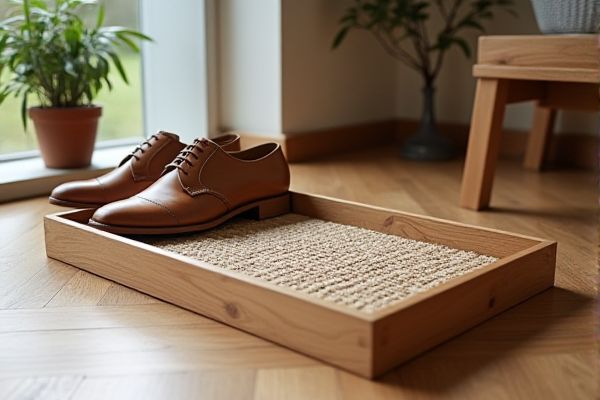
A shoe tray is designed to keep your footwear organized and prevent dirt from spreading on floors, while a drip tray is meant to catch liquids, such as water or oil, preventing spills and protecting surfaces. Discover how to choose the right tray for your needs and maximize cleanliness and convenience in the rest of the article.
Table of Comparison
| Feature | Shoe Tray | Drip Tray |
|---|---|---|
| Purpose | Collects dirt, mud, and water from shoes | Collects liquids from appliances or spills |
| Material | Plastic, rubber, or silicone | Plastic, metal, silicone |
| Design | Flat with raised edges or textured surfaces | Shallow basin or ridged surface to catch drips |
| Common Use | Entrances, mudrooms, indoor/outdoor | Under coffee machines, refrigerators, appliances |
| Size | Larger, designed to hold multiple pairs of shoes | Smaller, fits under specific appliances |
| Water Retention | High capacity for water and debris | Moderate capacity mainly for liquid spills |
| Maintenance | Easy to clean, rinse or wipe down | Requires frequent emptying and cleaning |
Introduction to Shoe Trays and Drip Trays
Shoe trays and drip trays serve distinct purposes in maintaining cleanliness and organization in your home. Shoe trays are designed to contain dirt, mud, and moisture from footwear, preventing floors from becoming dirty or damaged. Drip trays, on the other hand, catch liquid spills or excess water from plants, appliances, or pets, protecting surfaces from stains and water damage.
What Is a Shoe Tray?
A shoe tray is designed to hold and contain dirt, mud, and moisture from your footwear, preventing messes in entryways and storage areas. It typically features raised edges and a waterproof surface to protect floors and carpets from damage caused by wet or dirty shoes. Unlike drip trays used in kitchens or workshops for catching liquids, shoe trays specifically manage debris and spills related to footwear maintenance.
What Is a Drip Tray?
A drip tray is a flat container designed to catch liquids, such as water, oil, or chemicals, preventing spills and protecting surfaces from damage. Commonly used in kitchens, workshops, and cars, drip trays efficiently manage unwanted drips from appliances, machinery, or vehicles. Unlike shoe trays that specifically hold footwear and prevent dirt transfer, drip trays focus on liquid containment and spill prevention.
Key Differences Between Shoe Trays and Drip Trays
Shoe trays are specifically designed to hold and protect shoes from dirt and moisture, typically featuring a textured or ridged surface to prevent slipping and allow shoes to dry effectively. Drip trays are primarily used to catch liquid spills or drips from appliances such as air conditioners or refrigerators, often made from waterproof materials with raised edges to contain fluids. The key difference lies in function and design focus: shoe trays prioritize shoe organization and cleanliness, while drip trays are engineered to manage and contain liquid leaks.
Material Comparison: Shoe Tray vs Drip Tray
Shoe trays typically feature durable materials like plastic, rubber, or silicone designed to contain dirt, mud, and debris from footwear effectively. Drip trays are often made from metal, plastic, or coated steel, prioritizing liquid containment and easy drainage for spills or leaks. Choosing the right material depends on your specific needs, with shoe trays focusing on abrasion resistance and drip trays emphasizing waterproof and corrosion-resistant properties.
Purpose and Usage Scenarios
A shoe tray is designed to organize and protect floors from dirt and moisture brought in by footwear, making it ideal for entryways and mudrooms. A drip tray primarily collects water or liquids that drip from items like plants, appliances, or vehicles, commonly used underneath indoor plants, air conditioners, or car maintenance areas. Your choice depends on whether you need to manage footwear debris or capture liquid spills in specific locations.
Benefits of Using a Shoe Tray
A shoe tray effectively protects your floors from dirt, mud, and water tracked in by footwear, preserving cleanliness and preventing damage. Its raised edges and waterproof material contain spills and debris, making cleanup easier and maintaining a tidy entryway. You benefit from organized shoe storage, reducing clutter and extending the lifespan of your flooring.
Advantages of Drip Trays
Drip trays provide superior moisture control by effectively capturing water and preventing puddles, which helps keep floors dry and safe. Their durable, waterproof materials make them ideal for use in entryways, kitchens, or under plant pots, maintaining cleanliness easily. You benefit from hassle-free maintenance and extended protection for both flooring and furniture when using drip trays.
Maintenance and Cleaning Tips
Shoe trays require regular wiping and occasional deep cleaning to prevent dirt buildup and odors, making them ideal for managing mud and water from footwear. Drip trays, designed for collecting liquid spills, should be emptied frequently and cleaned with mild detergent to avoid mold and mildew growth. To maintain optimal hygiene, your chosen tray benefits from proper drying after each clean, ensuring a longer lifespan and better performance.
Shoe Tray vs Drip Tray: Which One Should You Choose?
A shoe tray is designed to organize and protect your floor from dirt and moisture tracked in by footwear, often featuring compartments or raised edges to contain debris. A drip tray, by contrast, is primarily used to catch liquids such as water, oil, or condensation, commonly placed under appliances or plants to prevent spills from damaging surfaces. Choosing between a shoe tray and a drip tray depends on whether your priority is managing shoe-related dirt or containing liquid spills, ensuring your space stays clean and protected efficiently.
 homyna.com
homyna.com